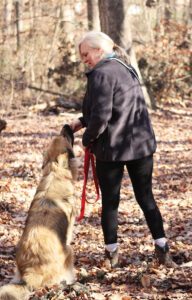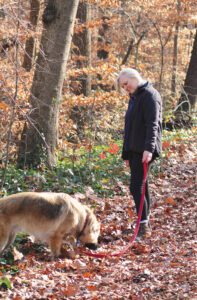If you need more information about How to Stop a Dog From Pulling on a Leash, you can check the following LINK.
To train your dog to walk on a loose leash, start with empathy for the dog’s needs. Meet those needs (and your own) by splitting the walk into thirds: sniffing, training, and loose-leash walking.

Any chance you’d like to transform your dog walks from frustrating leash-pulling contests of strength to enjoyable and cooperative outings? Using a pattern of three distinct types of interaction and activity on each walk gives you a strategy to stop a dog from pulling on a leash: a phase of high-engagement training, a phase of no-expectation sniffing, and your goal activity of loose-leash walking. When employed strategically, the three components work together to dramatically reduce pulling on leash.
Start with empathy for your dog’s needs
When a human client asks me to help them with their dog’s “problem behavior,” I make it a practice to wonder how the dog client would describe the problem. If they were in a couple’s counseling session, what would the dog have to say about their human?
When it comes to pulling-on-leash conflicts, I suspect most dogs would say, “Could you stop torturing me by bringing me outside and then forbidding me from enjoying myself? Our walks are weirdly slow and straight-ahead; can we make them more interesting, please? I’d like to smell some stuff, and it would be great to play some games part of the time.”
Sometimes, the fastest way to get what you want in a relationship is to make sure your partner gets what they want, too. In the case of the dog/human leash-pulling conflict, that means offering – structuring time for and facilitating – parts of the walk that will meet your dog’s species-specific needs. Using a pattern in every outing of intentionally switching from styles of walking that dogs enjoy most, to styles that work best for youwill transform that activity so that it’s more fun and less work for both of you.
“Ugh!” you might say. “That sounds complicated. I just want to walk my dog!” I know. But just give this a try for two weeks. You’ll be experiencing that gorgeous “J” shape in your leash more and more – and you may find that you feel closer to your dog and more connected to nature. I’m not promising world peace, but I swear good things will happen.
First Phase: Training
If I’ve got a dog who’s barely keeping it together at the beginning of the walk – bursting with energy – I start that walk by training with a super high level of reinforcement. Our initial steps down the driveway are going to be a string of cues: find it, heel, side, spin, heel, touch, heel, find it.
“Hey, lady, if it were that easy for me to get my dog to heel I wouldn’t be reading this article.” Fair point, but the devil is in the details. An authoritative (or annoyed) “heel!” is worlds apart from the rapid-fire fun I’m proposing. Here’s what my version involves:

- Head-turning food, whatever that means to your individual dog. I tend to start a walk with jerky in play, and then turn to less enticing stuff when arousal levels are lower and the dog and I have gotten into a groove.
- Rapid-fire cues. Ask for 10 different things in two minutes. Reward every single one at first! Don’t lose momentum. Keep your energy up to hold your dog’s interest. If your engagement flags, so will your dog’s. One particularly helpful exercise is “Fast! Slow! Fast! Side!” as you reward your dog for matching your varying pace.
- Enthusiastic vibe. Note that adding “training” sections to your walks does not mean “kill the fun by being very serious and demanding things.” Quite the opposite. This is your dog’s fun opportunity to earn extra yummy treats for doing stuff he knows how to do! How great is that? Demonstrate with a happy voice, good energy, and confident connection that this is an especially fun part of the walk.
Doing a “training” section of the walk right off the bat accomplishes a few important things. It gives the dog someplace to throw that initial big energy. It confirms that I have great food on me, which will be important as we pass challenging things like that barking German Shepherd around the corner. And it starts us off psychologically together, engaged. That sets us up for better loose-leash walking.
Second Phase: “Go Sniff!”

“Go sniff!” is something the dogs I’m working with hear maybe a half a dozen times in a half-hour walk. That’s the signal that they can go ahead and inhale the world to their heart’s content for the next few moments. I won’t rush them or pull them away.
We humans with our 6 million nasal receptor sites cannot fathom what dogs can smell with their 100 million. That’s why it’s so natural for us to say after two seconds, “C’mon, there’s nothing there!” The dogs beg to differ. The information they gain by sniffing is probably akin to our scanning our email, news headlines, and social media gossip. I imagine they can smell the raccoons that walked down the sidewalk yesterday, the pizza that was delivered last night, the UPS driver’s cat whose fur is on the guy’s shoe, and all the other dogs in the neighborhood that passed by in the past few days. By reading the pee-mail left by other animals, and commenting with some pee themselves, they gain and share important information.
Even if you don’t take delight in your dog’s sensory experience, keep in mind that it’s also in your self-interest to let your dog sniff. Allowing our dogs to really be dogssometimes makes it a heck of a lot easier for them to live according to our human rules the rest of the time. Sniffing is, hands-down, the easiest way to help your dog obtain his required daily allowance of dogness. This kind of data-gathering for your dog can also help enormously with anxiety and reactivity. Plus, it’s not difficult for you to provide and you don’t have to learn anything or plan anything; just stand still for a few moments or minutes while they sniff!
So the case for sniffing on walks is very strong; the key is to make it official. Obviously you don’t want your dog yanking you hither and yon whenever they catch a great scent – which is exactly what happens when we never give our dogs the option to sniff in a leisurely fashion. Faced with that utterly unfair situation, dogs will take their welfare into their own hands, put their heads down and drag their owner to the bushes.
In contrast, if an owner regularly makes a point of noticing where good smells tend to be and – just as that spot comes up, before the dog tries to pull for it – says, “Go sniff!” the entire dynamic changes. After a few weeks of this kind of pattern, the dog isn’t desperately pulling toward everything, because she can trust that she’ll get a chance pretty soon.
Third Phase: Loose-Leash Walking
Now we get to the whole reason you started reading – the loose-leash part. I started with the other sections because that mimics my typical progression: When I’m just starting to work with a dog, I expect to do a lot (maybe 15 minutes?) of alternating between sniffing and high-engagement training before we get to a place where we’re going to succeed with a section of loose-leash walking. In essence, I wait until I’ve met some natural canine needs, drained some energy, and reminded the pup that engagement with me is incredibly rewarding.
After a sniffing session, I’ll say, “Bella, let’s walk!” to indicate we’re officially in a new pattern together. Then we move ahead. I’m looking for that leash to be in a nice “J” the whole time. If the dog pulls so that the leash becomes taut, I simply stop moving. I wait. She’ll look back, which usually also creates slack. I reward that slack leash with movement forward: “Let’s walk.” If it tightens again, we repeat that cycle. Soon enough the dog learns that walking in sync with me offers its own reward: forward motion.
If I try the stop-at-every-taut-leash business with a new dog right out of the gate, it’ll be a very frustrating exercise for us both; we’ll be stopping every two feet. Many folks approach loose-leash training that way, but I don’t enjoy that one bit. Instead, if we’ve been alternating between lots of high-reward training and sniffing for 15 minutes or so, I’m set up to succeed with getting that loose leash without frustration. In fact, some pups will then be ready to relax into this style for much of the rest of the walk. Others do best if I continue to alternate sniffing, training, and loose-leashing the rest of the way.
IT’S A JOURNEY
When a dog is new to all of this, I’m highly deliberate and communicative so that we both know which part of the walk we’re in at all times: sniffari, training, or loose-leash walking. As time goes on, though, the need for that precision fades away. That early, predictably clear structure allows for mutual learning that paves the way for mutual trust – and that trust turns out to be the key.
For me, walks are about the relationship. When it comes to getting a “polite” walk, there is tons of chatter out there about equipment and complicated training instruction, but to me that mostly misses the point. What gets you to an enjoyable walk with your dog is two-way connection. Get that right, and watch the leash loosen.
Last note: Could you get a loose leash fast by using aversive tools and methods? The ones that use pain (at the very least, discomfort) and fear to ensure compliance from your captive animal? Sure. But . . . is that who you want to be? I promise it’s more fun – and much more effective in the long run – to not resort to using these tools.
Get even more great ideas about How to Stop a Dog From Pulling on a Leash by visiting our recommendation website with LINK. Thank you for visiting l2sanpiero.com with article How to Stop a Dog From Pulling on a Leash. Good luck and see you in the next article